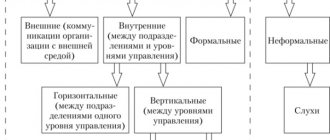Speech as a means of communication
Verbal (from Latin verbalis - verbal) communication is carried out using speech or language.
Speech is a natural sound language, that is, a system of phonetic signs (words), which include two principles - lexical and syntactic. Speech is a universal means of communication, since when transmitting information with its help, the meaning of the message will be least likely to be lost.
Verbal means of communication are written and spoken speech, reading and listening. With the help of oral and written speech, a text is created, which is a process of transmitting information, and listening and reading help to perceive the text that contains information.
36. Speech as a means of communicationCommunication
- this is communication between people, reflecting the level of their awareness in any area, serving as a means of transmitting information and, in general, being a necessary “attribute” in the life of every person.
There is, for example, the language of the deaf and dumb, and this is also a means of communication, as it conveys information, and can do this quite emotionally. Even silence itself can be a means of communication, conveying information based on emotional intensity or the length of the pause.
But still, the best means of communication, i.e. transmitting information, is human speech.
The term “speech” has not one, but three meanings. The first is speech as the process of speaking; second - speech as a product of speaking, i.e. text (no matter whether written or oral); and third - speech as an oratorical genre.
In the first case, we mean fluency in the mechanism of speech, i.e., how intellectually developed a person is, how quickly he can choose the right word, the purity of his speech, the absence of pronunciation defects. Most often, this term refers to everyday colloquial speech that everyone speaks, good or bad. The main task of this type of speech is to convey information to the listener, and for this it is not necessary to have special oratorical abilities, as in the third definition of speech, where speech is elevated to the rank of art. In this case, speech is not just a means of communication, although it also carries information. This is a beautiful, delivered speech that has a goal, objectives and topic. It is designed for a specific listener. And if it is considered as a process, it is more subtle and psychologically calculated. The speeches of the great speakers remained in the memory of posterity as evidence of the culture and high level of development of the people who spoke them. But once again it should be emphasized that these speeches are designed for human psychology, the beauty and power of words.
The second meaning of speech, i.e. speech as the result of a process, is addressed to the choice and use of language means: phonetic, lexical. The text carries information, but is not a means of communication in the full sense of the word.
What is more important for us is speech as a process, what means of language are used in colloquial speech in order to make it more informative and at the same time more emotional. Such means include all kinds of vernaculars, proverbs and sayings, which, on the one hand, reduce the level of normativity of speech, on the other, enrich it. The speaker’s speech should be simple and figurative enough so that the listener does not have any misunderstandings. In colloquial speech, such a linguistic technique as asking again is often used. Usually it demonstrates the insufficient level of language proficiency of the interlocutors.
Those participating in communication have their own role, which is associated with certain rights and responsibilities of communicants, opportunities and limitations of communicative behavior.
The main communicative roles are identified, such as the roles of addresser, addressee and observer.
Addressee
is a speaking, writing text producer who directs his speech activity at the addressee, thereby influencing him as an object of speech.
At the same time, this addressee-object can be considered as the second subject of the speech act, the interlocutor in communication. Especially such relationships between the addresser and the addressee are manifested in dialogue with its inherent change in communicative roles. Each participant in the conversation can play either the role of the addresser or the addressee in the dialogue, and the unfolding sign communication reflects the positions, properties and speech activity of both. Such relationships can manifest themselves both in written communication and in the monologue of speech, although they are expressed indirectly in these cases. The main essence of communication
is the transfer of information. And information can be conveyed in completely different ways, the main thing is that the interlocutors understand each other. Information can be conveyed by non-verbal means of communication - gesture, nod of the head, facial expressions, etc.
For stylists, colloquial speech can be interesting from a research point of view, since live speech is constantly changing, and tracking these changes is very important. There is also normative, or literary, speech. It is more likely to come into contact with oratory, since public speaking can be a striking example of it.
Table of contents
Types of speech activity
From the point of view of the mechanisms of encoding - decoding information, speech activity consists of four main aspects, called types of speech activity: speaking, listening, writing, reading.
- Speaking is the sending of speech acoustic signals that carry information.
- Hearing (or listening) is the perception of speech acoustic signals and their understanding.
- Writing is the encoding of speech signals using graphic symbols.
- Reading involves deciphering graphic signs and understanding their meanings.
A person activates information encoding mechanisms when he speaks and writes, and decoding mechanisms when he listens and reads. When speaking and listening, a person uses acoustic signals, and when writing and reading, he uses graphic signs.
These types of speech activity are the basis in the process of speech communication. The effectiveness and success of a person’s verbal communication depends on how well the person has developed the skills of these types of speech activities.
Speech can be divided into internal, when a person mentally talks to himself, through which he realizes the motives of his behavior, plans and manages activities; and external, which is aimed at the communication partner (Fig. 1). Inner speech is not communication because it does not involve dialogue.
Rice. 1. - Types of speech
Inner speech is the basis for outer speech. When translating the content of internal speech into external speech, there is a difficulty in speaking out loud (this can be seen in the students’ oral responses, which clearly reflect these difficulties).
Types of external speech
External speech can be oral and written.
Oral speech
Oral speech is a type of external speech in which words are voiced; it uses a system of phonetic and prosodic means of expression. This type of speech appears in the process of speaking. It is characterized by verbal improvisation and some linguistic features: freedom in the choice of vocabulary prevails, simple sentences are used, incentive, interrogative, exclamatory sentences, repetitions, and incomplete expression of thoughts are used.
Do you need help from a teacher? Describe the task - and our experts will help you!
Written speech
Written speech is a type of external speech when words are graphically consolidated. It can be thought out and corrected in advance. It is characterized by some linguistic features: it is dominated by book vocabulary, complex sentences, strict adherence to language norms, and there are no extra-linguistic elements.
The difference between oral and written speech
These differences must be taken into account in the process of business communication. They lie in the character of the addressee. Written speech is usually directed to those who are absent. People who write cannot see their communication partner, but can only mentally imagine him. Written speech is not influenced by the reactions of people who perceive it when reading it.
Oral speech presupposes the presence of an interlocutor. The one who speaks and the one who listens, in most cases, not only hear, but also see each other. Therefore, oral speech is dependent on its perception by other people. Reactions of approval or disapproval, demonstrations of understanding or misunderstanding can influence the nature of speech and change it depending on this reaction.
A person who speaks creates his speech immediately: he must simultaneously present both content and form. The one who writes always has the opportunity to change his text and correct it at his own discretion.
The nature of perception of oral and written speech
The perception of oral and written speech is different. Written speech is calculated with the condition for visual perception. When a person reads, he has the opportunity to re-read any passage several times to check the correctness of understanding. Oral speech is perceived by ear, so it should be constructed and organized in such a way that its content can be understood immediately and easily absorbed by listeners.
The difference between written and oral speech also lies in the fact that what is said and pronounced is short-lived, it remains in memory only partially, but what is written can be retained for a long time, as is said in the proverbs: “The word is not a sparrow, it will fly out - you won’t catch it”; “What is written with a pen cannot be cut out with an axe.”
Is it still difficult? Our experts will help you figure it out All services Problem solving from 1 day / from 150 rubles Coursework from 5 days / from 1800 rubles Abstract from 1 day / from 700 rubles —>
Types of speech activity and their features.
BASIC CHARACTERISTICS OF VERBAL COMMUNICATION
Plan
1. Speech as a means of communication: concept, functions and structure.
1. Speech as a means of communication: concept, functions and structure.
Verbal communication uses human speech and natural sound language as a sign system that mediates information interaction and communication[vi]. Speech is the most universal and important means of communication. According to scientists, two-thirds of human communication consists of verbal communication. Moreover, with the help of speech, the meaning of the message is least likely to be lost. True, this should be accompanied by a high degree of common understanding of the situation by the participants in the communicative process. Let's take a closer look at some of these issues.
Concept (term) “speech”
used in several meanings.
1. Speech as a special type of human activity, which exists along with other types of activity (labor, cognitive, etc.) and at the same time constitutes a component of all other types of activity.
2. Speech as a type of communication through language, which occurs in audio, written or other form. It is characterized by a set of certain lexical and grammatical means and is determined by the conditions and goals of communication, depending on which business, official speech, poetic speech, professional speech and etc.
3. Types of syntactic structure of a statement (indirect direct speech, abrupt speech, someone else’s speech, etc.).
4. Speech as a result of speech activity - text, article, message, report, etc.
Speech is the external manifestation of language. Language is realized in speech and only through it fulfills its communicative purpose.
Speech is a sequence of language units, organized and structured according to its laws and in accordance with the needs of the information expressed. Unlike language, speech can be assessed as good or bad, clear or incomprehensible, expressive or inexpressive, etc. The speaker (writer), carrying out this activity, uses the means of language for two main purposes: to communicate with other people or to communicate with to myself. Thus, speech as a psychological phenomenon correlates with the categories of thinking, memory, etc.
Functions of speech (language).
Each utterance performs one or another function in the communication process (attracting attention, establishing contact, transmitting information, etc.). Particular functions of specific utterances can be combined into more general ones, which are called functions of speech. Usually there are three main and a number of special functions.
The main functions include:
· communicative or representative
(representation - representation; image, image), which is dominant;
· appellate
(appeal - appeal, appeal, i.e. influence), which is grammatically most clearly expressed in the vocative form and the imperative mood (Andrey! Come here!);
· expressive
(expression - expression and expressiveness).
Among the private functions are:
· phatic
carried out through the exchange of ritual formulas, i.e. primarily affecting the area of speech etiquette (Good afternoon. Glad to see you. - Mutually. How are you doing?);
· metalinguistic
, i.e. interpretation function, when the speaker or listener needs to check whether they use the same code when communicating; thus, the subject of speech becomes the code itself (Do you understand what I mean? Clarify what you understand by the word happiness?).
In addition, they talk about poetic, emotive, voluntarily and a number of other functions.
However, it is unlikely to find speech messages that perform only one of these functions. The differences between messages do not lie in the exclusive manifestation of any one function, but in their different hierarchy. The verbal structure of a message depends primarily on the predominant function.
Thus, the system of speech functions represents a hierarchical structure. To fulfill its primary function as a means of communication, speech must perform specific functions of communication and message. To implement the latter, it is necessary to formalize thoughts, i.e. a representation function is assumed. Its constituent and subordinate parts are the functions of expression and appeal. In fact, the function of representation is impossible without both of its components, but they are also impossible without it. Thus, in the process of any speech act, private functions are also realized. At the same time, the nature of the impact on the interlocutor depends on which function predominates in a particular speech message.
The structure of verbal communication includes:
1. The meaning and meaning of words and phrases. The accuracy of the use of the word, its expressiveness and accessibility, the correct construction of the phrase and its intelligibility, the correct pronunciation of sounds and words, the expressiveness and meaning of intonation play a role.
2. Speech sound phenomena: speech rate (fast, medium, slow), voice pitch modulation (smooth, sharp), voice pitch (high, low), rhythm (uniform, intermittent), timbre (rolling, hoarse). Observations show that the most attractive in communication is a smooth, calm, measured manner of speech.
3. Expressiveness of voice quality: characteristic specific sounds that arise during communication: laughter, grunting, crying, whispering, sighs. Studies have shown that in the daily act of human communication, words make up 7%, intonations 38%, non-verbal interaction 53%.
People need to communicate with each other and with themselves, and also receive information from universal human socio-historical experience.
All these functions are provided by speech. Speech as a means of communication is the topic of today’s conversation.
Speech is the result of recoding thoughts into sound or graphic structures. When communicating through speech, three main elements function:
- subject of speech communication (who speaks),
- object (recipient) of the message;
- the speech message itself.
This means that success depends on three factors :
- characteristics of the speaker,
- the mental state and state of perception of the person receiving the message;
- quality of speech “products”.
The speech process is associated not only with mental manipulations of the psyche, but also affects the spheres of interpersonal and personal relationships. The attitude towards the situation is also conveyed through speech.
Let's look at what helps transmit speech:
- tone;
- voice volume;
- focus of gaze;
- certain body movements.
The tone of speech is a kind of indicator of the speaker’s mental state. The interlocutor very accurately grasps whether the speaker himself believes in his own words, what meaning he attaches to what was said, how he treats the person with whom he is communicating.
Voice volume . It also shows the intentions of the speaker and his attitude towards those who listen to him. For example, if they want to exert pressure or influence, they speak louder. In Europe, if they are indignant, they also increase the strength of their voice. but in the East in such cases they switch to a whisper.
Focus of gaze . Shows the true mood of the speakers and serves as a channel of communication between them. When embarrassed, the eyes usually droop, and an averted gaze can indicate the speaker’s insincerity.
Body movements. Strengthens the speaker's self-expression. Different cultures have their own norms of body movements, distance between interlocutors and gestures. We talk more about body language in European culture and its influence HERE.
However, the basis of verbal communication is the message itself. One should remember the unity of its content and form .
Content. Some people are used to just chatting, without really thinking about what they say. But any message carries not only information, but also a charge of energy. Later we will talk about how, for example, we program ourselves for ill health with the help of phrases, how we bring disaster upon ourselves. In the meantime, we are talking about speech as a means of communication.
Form. Even the most striking content will be lost and will not have the desired impact on listeners if it is presented in an inexpressive or inappropriate form.
So, if the feelings that we convey in poetry are presented in the form of an information note, then not only will the meaning of what was said or written be lost, but the text will seem pompous and insincere.
Construction of speech according to the laws of speech communication:
- assess (determine) the situation;
- we determine our attitude to the situation (i.e., reaction to the situation);
- explains what one would like to do (motivation for activity).
If the speaker loses control over emotions, then this structure changes. Often, first of all, statements are used that are not confirmed by an adequate assessment of the situation, for example, offensive ones. And when, having calmed down, we carry out the exercise of assessing the situation, we become ashamed. Moreover, such behavior can greatly damage relationships with people.
“Provocateur” words can also ruin relationships with people and cause conflictual communication: read about them HERE.
Usually in such cases the interlocutor either answers in the same spirit or remains silent. Negative emotions of the speaker generate negative emotions in the interlocutor (according to the law of generating emotions in the process of communication).
Conclusion: to avoid unpleasant situations, send messages imbued with positive emotions.
Definition of the situation . The speaker creates a picture of what is happening, records events and his attitude towards them. At the same time, if we want speech to have a greater impact, we look for bright, rich expressions, like a painter, we draw pictures, only with words:
“For one lost day, the enterprise loses so much. How much will it miss for thousands of lost days?! (numbers…)"
In speech, it is better not to use categorical expressions “never”, “always”, “forever”, etc., as well as evaluative cliches: “slobs”, “fools”, “parasites”... You should avoid anything that degrades human dignity.
Reaction to the situation. It is appropriate to express concern, experience, and surprise. Sarcasm and indignation can only be used if you intend to break up with the person.
However, it is better to avoid rage and insults, especially with obscene language, in any case. Such an attitude can temporarily stimulate only uninitiated performers and people-pleasers. Such a negative attitude disorganizes independent, creative and self-sufficient people.
Inspiration to activity. The speaker specifically, clearly, clearly formulates his advice, recommendation, request or reasoning.
Next time we will talk about the properties of good speech in communicating with people.
In the meantime, tell me, what kind of speech in communication would you call high-quality?
Did you like the post? Share it with your friends! —>
Speech is the main means of human communication.
Speech is the process of communication between people through language . With its help, a person receives and transmits information. Speech records what cannot be perceived with the help of the senses (abstract concepts, laws, rules). Written speech allows you to obtain information about the life of previous generations. Thanks to speech, a person’s personal experience is enriched by the experience of other people.
There are 4 main functions of speech:
o Expression -
We express our attitude towards a certain object, situation, person.
o Message –
Through words, information is exchanged between people.
o Designation –
we name objects and phenomena.
o Impact –
We influence the thoughts, emotions, and behavior of other people.
Its basic properties are directly related to the functions of speech
— Content–
volume and depth of information expressed in speech.
— Understandability–
the ability to use words, sentences, and concepts appropriate to the situation.
— Expressiveness –
emotional richness and coloring, the content of figurative expressions, metaphors, the ability to evoke a response in the interlocutor.
— Impact
– the ability to influence other people) their beliefs, emotions, motivation, etc.)
Speech involves the use of language - a means of communication between people; system of signs.
Language -
a socio-historical phenomenon determined by national characteristics. It exists independently of the individual. A language that is not used for live communication, but preserved in written sources, is called dead (for example, Latin).
Sign -
This is any material, sensory element of reality, acting in a certain meaning and used for storing and transmitting information. Linguistic signs do not exist in isolation from each other, but form a system that is built according to certain rules, creating the grammar of the language.
Signs that are part of languages as special means of communication between people are called signs of communication:
Natural languages -
These are words, accepted expressions, grammatically correct sentences, etc., which consist of sound signs and corresponding written signs. These include accepted systems of combinations of finger positions (language of the deaf and dumb), tattoos on paper (language of the blind). Telegraph code, signals given by flags, drum system, etc. can be used as linguistic signs.
Artificial
– encode natural languages (Morse code, traffic signs, etc.)
Speech without language acquisition is impossible, but language can exist and develop independently of a person.
The individuality of speech is explained by age, different levels of language proficiency (vocabulary, grammar, phonetics), education, and general cultural level. The speech of individual people reveals their professional characteristics, peculiarities of construction and pronunciation (for example, one person pronounces sounds clearly, clearly, loudly, another - indistinctly, quietly, slowly, a third - burrs, etc.), interest.
A person can use one language or several.
HomeCollection “Otherreferats”Psychology Speech as a means of communication
Speech communication as a method of communication
One of the main means of communication is speech, speech communication.
According to scientists, half a third of human communication consists of verbal communication. The concept of “speech” has several meanings: • a special type of human activity; • a type of communication using language (what is usually called a language style, a syllable), which is characterized by certain lexical and grammatical means depending on the conditions and goals of communication (business official speech, poetic speech, professional speech, etc.);
• types of syntactic construction of a statement (indirect
direct speech, abrupt speech, someone else’s speech, etc.).
We are primarily interested in the first meaning. Speech is a type of activity that exists along with other types of activity
(labor, cognitive, mnemonic, i.e. activity: memory, etc.).
Since “speech activity is a specialized absorption of speech for communication,
a special case of communication activity,” “speech is a potential component
of any
activity, for example, cognitive (mental), mnemonic, etc.”
(L* tyev A.A.
Psychology of communication. M., 1999. P. 56). The speaker (speaker), carrying out this activity, uses the means of language for two main purposes: to communicate with other people or to communicate with himself. Thus, speech as a psychological phenomenon correlates with the categories of thinking, memory, etc.
In linguistics, speech is studied within the opposition language - speech is usually understood as the implementation of a language system. This oppositionist;
was first identified and described by Saussure in his “Course of General Linguistics” (1916).
Saussure viewed speech activity as a kind of integral of language and speech. Language is, as it were, a potency, a certain system, the structure of which has not yet been fully studied, but which, despite this, is known to all members of a given linguistic community and is a product of its activity, i.e. is of a social nature. The language system finds its implementation in speech, i.e. language is constantly present in us in a state of possibility. Speech is actual, individual; speech is present in us from time to time in a state of reality. Developing Saussure's idea, researchers suggest that “speech activity as a whole, as an integral, contains a sequence: this is the sequence of transition of language, which constantly exists in the speaker (hence, regardless of the specific moment), to speech (into speech), which belongs to the speaker only in specific moments in time" (Guillaume G.
Principles of theoretical linguistics. M., 1992. P. 37).
The nature of the impact of the speaker’s (writer’s) speech on the interlocutor (reader) depends on how this transition is carried out.










